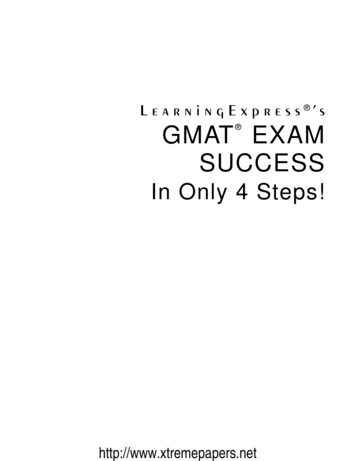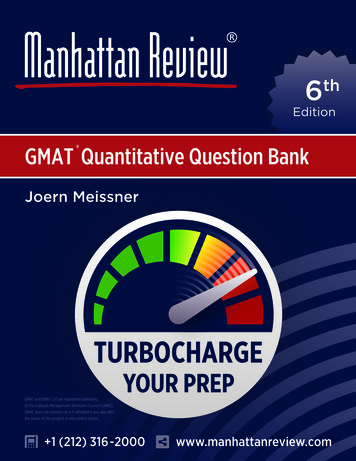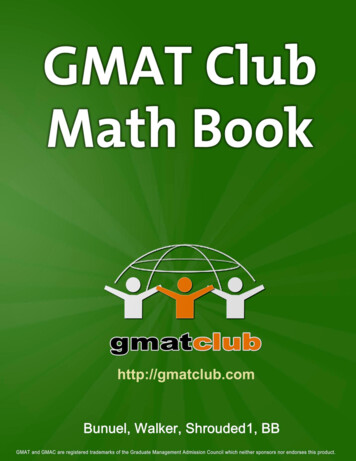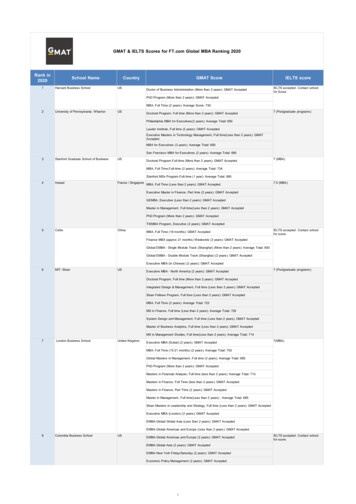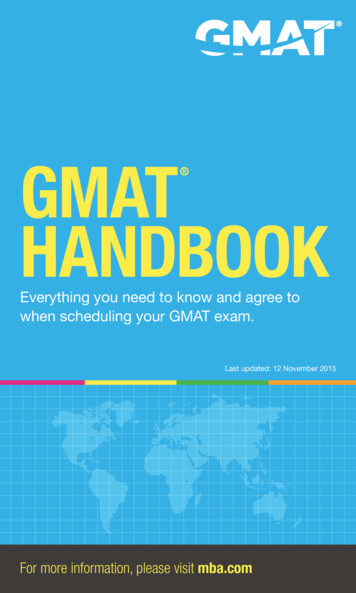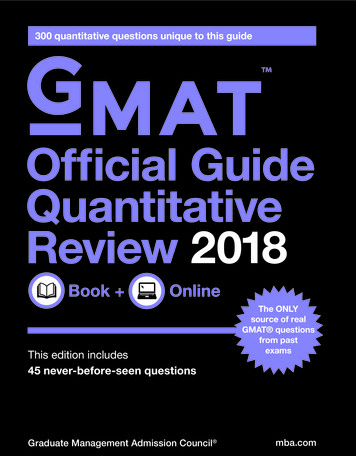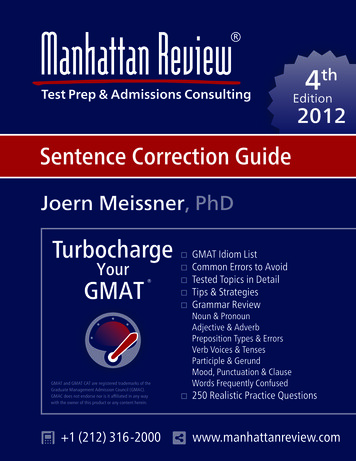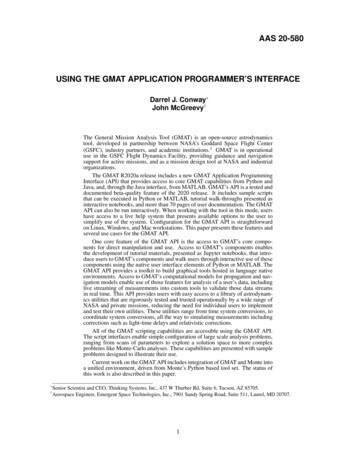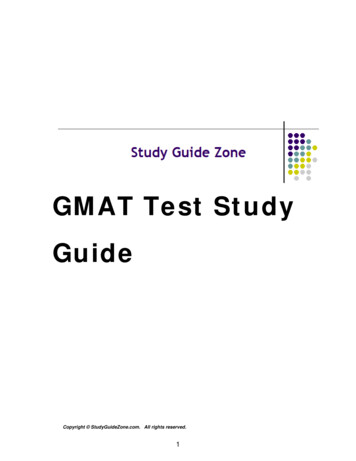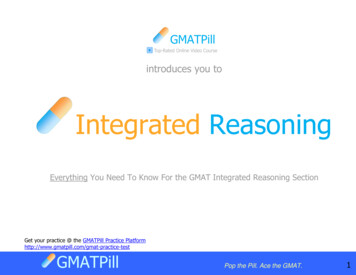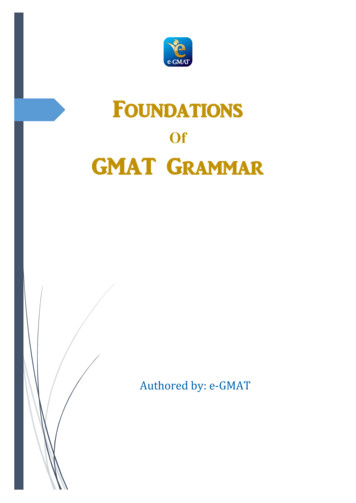
Transcription
FoundationsOfGMAT GrammarAuthored by: e-GMAT
Table of contentsNouns. 1Concrete & Abstract Nouns . 1Proper & Common Nouns . 1Singular and Plural Nouns . 2Countable and Un-Countable Nouns. 2Pronouns . 4Types of pronouns. 4Verbs . 6Linking verbs . 7Base form of Verb . 8Helping verbs . 9Verb Tenses . 10ADJECTIVES . 15Adjectives – Words, Phrases, and Clauses . 15Adjectives – for comparisons . 16Comparative form. 17Superlative form . 17Adverbs . 17How are Adverbs formed? . 18Adverbs – Words, Phrases, and Clauses . 19Adverbs – for comparisons . 19Prepositions . 20Conjunctions . 21Articles . 22Indefinite Article . 22Definite Article . 23
NounsA noun is a word that denotes a person, place, or thing, e.g. Tom, apple, laughter,PhoenixExample Sentence 1 - Tom went around the world, from California to Cairo, by ship.All underlined words are nouns. Tom Name of the personworld placeCalifornia Name of the placeCairo Name of the placeship thingConcrete & Abstract NounsNouns can be either concrete or abstract, depending upon what type of entity theydenote.Concrete Nouns denote items that one can identify, using any of the 5 senses –sight, touch, taste, smell, & sound. E.g. all nouns in the example sentence 1 (Tomwent ship.) are concrete nouns.Abstract Nouns denote items that cannot be detected by the 5 senses. E.g. love,truth, pain, skill.Proper & Common NounsNouns can be either proper or common, depending upon whether they expressspecific names or generic entities.Proper Nouns name specific persons, places, or things. They are capitalized. Inthe example sentence 1, the nouns ‘Tom’, ‘California’, and ‘Cairo’ are all propernouns since each of these nouns is the name of a person or a place.Common Nouns are general nouns. In the above sentence, the nouns ‘world’ and‘ship’ are common nouns. e-GMAT LLC. Unauthorized copying for commercial and competitive purposes is not allowed.1
Singular and Plural NounsNouns have a number associated with them. Since they express entities, they caneither express a single entity or a plural entity. Thus, nouns can be singular orplural. Singular means one. A noun in its native form is singular: e.g. – ship. Plural means more than one.Typically, most nouns can be made plural by adding –s, –es or –ies after the noun.E.g. ship is singular; ships is pluralinjury is singular; injuries is pluralCertain other nouns have distinct plural forms. E.g. man is singular; men is pluralchild is singular; children is pluralmouse is singular, mice is pluralCountable and Un-Countable NounsClassification of nouns as countable and uncountable nouns is important becauseit governs the use of certain adjectives with these nouns, as explained below. What is a countable noun?A countable noun is a word that can be counted and has a plural form. Forexample:The word ‘onion’ is a countable noun because: It can be counted as one onion, two onions, three onions, etc.It has a plural form (onions).The word ‘reason’ is a countable noun because: It can be counted as one reason, two reasons, three reasons, etc.It has a plural form (reasons).By the same reasoning as above, words such as ‘thing’, ‘job’, ‘coin’, ‘story’, etc. arecountable nouns. e-GMAT LLC. Unauthorized copying for commercial and competitive purposes is not allowed.2
What is an un-countable noun?An un-countable noun is a word that cannot be counted and that *usually does nothave a plural form. For example:The word ‘garlic’ is an un-countable noun because: It cannot be counted as one garlic, two garlics, three garlics, etc.It does not have a plural form (garlics).The word ‘knowledge’ is an uncountable noun because: It cannot be counted as one knowledge, two knowledges, threeknowledges, etc.It does not have a plural form (knowledges).By the same reasoning as above, words such as ‘stuff’, ‘furniture’, *‘money’, ‘rice’,‘anger’ etc. are un-countable nouns.*The noun ‘money’, which is usually an un-countable noun, has a plural form‘moneys’, which is used in a very different context and not in the context of ‘onemoneys’, ‘two moneys’, etc. How can I determine whether a noun is countable or un-countable?A noun is countable noun if: It can be counted as 1 (noun), 2 (nouns), 3 (nouns)It has a plural form.A noun is un-countable noun if It cannot be counted as 1 (noun), 2 (nouns), 3 (nouns)It does not have a plural form. What adjectives can be used with countable and un-countablenouns?Quantity adjectives such as ‘few’, ‘many’, etc. can only be used with countablenouns. For example, you can say ‘few songs’ because here ‘songs’ is a countablenoun, but you can’t say ‘few music’ because ‘music’ is an uncountable noun.Similarly, you can say ‘many songs’; but you can’t say ‘many music’.Quantity adjectives such as ‘less’, ‘amount’, etc. can only be used with un-countablenouns. For example, you can say ‘less music’ because here ‘music’ is an uncountable noun, but you can’t say ‘less songs’ because songs is a countable noun,and ‘less’ cannot be used with countable nouns. e-GMAT LLC. Unauthorized copying for commercial and competitive purposes is not allowed.3
Similarly the expression ‘amount of music’ is correct, while the expression ‘amountof songs’ is incorrect idiomatic usage.PronounsPronouns take the place of a noun to avoid repetition and to clearly express themeaning of the sentence. E.g.1.2.The teacher walked in to the class and saw that the students doing thegroup assignment were too loud, so the teacher told the students thatthe group assignment would have to end if the students did not controlstudents’ volume.Teacher walked in to the class and saw that the students doing thegroup assignment were too loud, so he told them that the groupassignment would have to end if they did not control their volume.Notice how in sentence 1, the nouns are repeated, and, therefore, the sentence isclumsy and difficult to comprehend. On the other hand, in sentence 2, pronounsare used in place of the nouns, and the sentence becomes much more precise andclear.Since pronouns replace nouns, they also express the name of a person, a place, ora thing. E.g.1.2.Tom was angry at Sheila for not taking Tom to the Central Park, as Tomloves to go to the Central Park for picnics with Sheila.Tom was angry at Sheila for not taking him to the Central Park, as heloves to go there for picnics with her.Types of pronounsThere are 5 types of pronouns.1. Personal PronounThese pronouns refer to specific people or things. For example: he, she, they, etc.When you use personal pronouns, you should take care to use them in the correctcase or form.1.1 Subject Case Pronouns – I, You, She, He, It, We, TheyBe sure to use a subject case pronoun when the pronoun acts as a subject in thesentence. For example: e-GMAT LLC. Unauthorized copying for commercial and competitive purposes is not allowed.4
a.b.Sheila slept before the sunset.o She slept before the sunset.Tom and Sheila left the meeting early to attend a gala event.o They left the meeting early to attend a gala event.1.2 Object Case Pronouns – Me, You, Her, Him, It, Us, You, ThemLikewise, use object case pronouns when the pronoun acts as an object in thesentence. For example:a.b.Assign the task to Sheila.o Assign the task to her.Tom needs to meet Sheila and James.o Tom needs to meet them.1.3 Possessive Case Pronouns – My, His, Her, Their, ItsLikewise, use possessive case pronouns when you need to show ownership. Forexample:a.b.Sheila’s share of chocolate is almost over.o Her share of chocolate is almost over.The students’ books are torn.o Their books are torn.2. Relative PronounsThese pronouns connect group of words to specific nouns. They are called relativepronouns because they relate to the word that they modify. For example that,which, where, whose, etc are relative pronouns.a.b.The book that contains the details of the experiment was stolen. (‘that’relates to the noun ‘book’)The barren land, which has not been cultivated since ages, belongs toan old couple, who cannot hire any help. (‘which’ relates to the noun‘land’ and ‘who relates to the noun “old couple’)3. Indefinite PronounsThese pronouns refer to people and things that are not specific. For example all,everyone, each, everything, anyone, anything, etc are indefinite pronouns.a.b.Everyone has the right to vote in this country.Each student needs to sign the attendance sheet.4. Demonstrative Pronouns e-GMAT LLC. Unauthorized copying for commercial and competitive purposes is not allowed.5
These pronouns refer to the nouns that follow them. For example this, those etcare demonstrative pronouns.a.b.These shoes are mine.This box contains several antique items.5. Reflexive PronounsThese pronouns are used when the subject of the sentence does something toitself. These pronouns end in –self or –selves. I cut myself while chopping the vegetables.We also use these pronouns to emphasize the subject. They themselves cannot handle the situation. Singular and Plural PronounsLike a noun, a pronoun can be either singular or plural. Some singular pronounsare he, it, I, her, this etc. Some plural pronouns are they, we, us, them, those etc.VerbsA verb is an essential component of a sentence. A sentence is not complete withouta verb and its subject. Typically, verbs denote the action performed by the subject.For example: The clock ticks all day long.“ticks” is an action verb here as the clock is the doer of the action. The clockdoes the action of ticking. The beggar sat down by the side of the road.“sat” is the action verb here, and the doer of this action is the subject of thesentence – “the beggar”.On several occasions, verbs, instead of presenting the action of the subject, simplyconnect the subject to some other additional information about the subject. Insuch cases, they are called linking verbs. Let’s take a closer look at such verbs. e-GMAT LLC. Unauthorized copying for commercial and competitive purposes is not allowed.6
Linking verbsVerbs can also connect or link the subject to additional information about thissubject. Such verbs are called linking verbs.For example: My mother is a great cook.
e-GMAT LLC. Unauthorized copying for commercial and competitive purposes is not allowed. 1 Nouns A noun is a word that denotes a person, place, or thing, e.g. Tom, apple, laughter, Phoenix Example Sentence 1 - Tom went around the world, from California to Cairo, by ship. All underlined words are nouns. Tom Name of the person world place California Name of the place .
